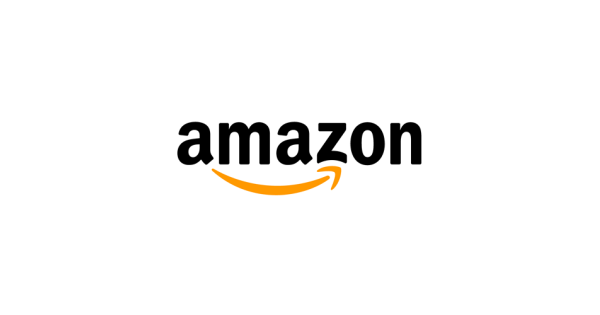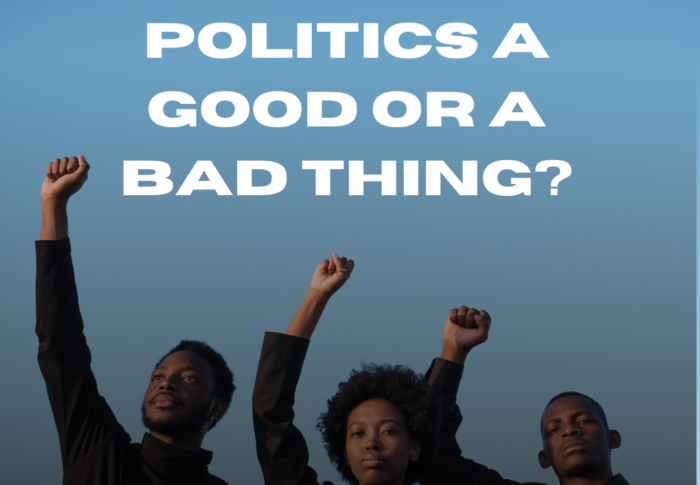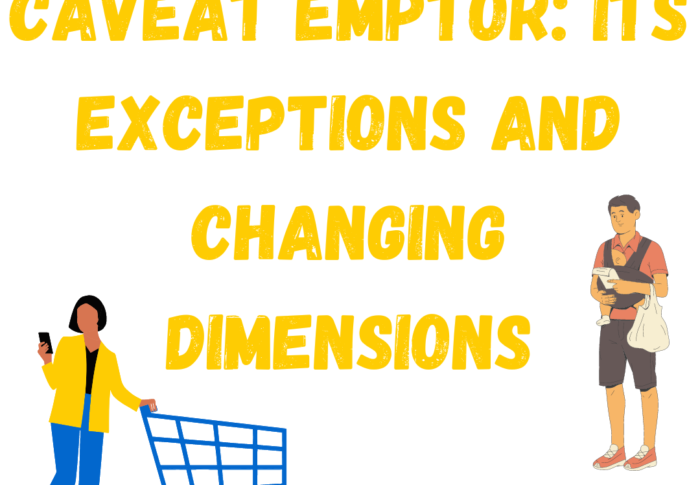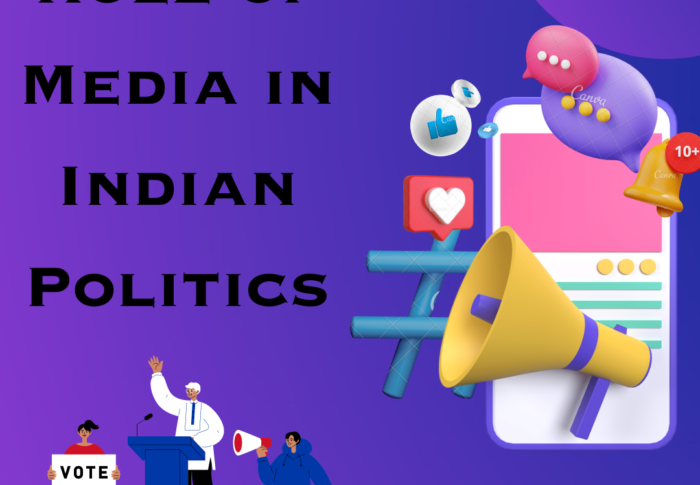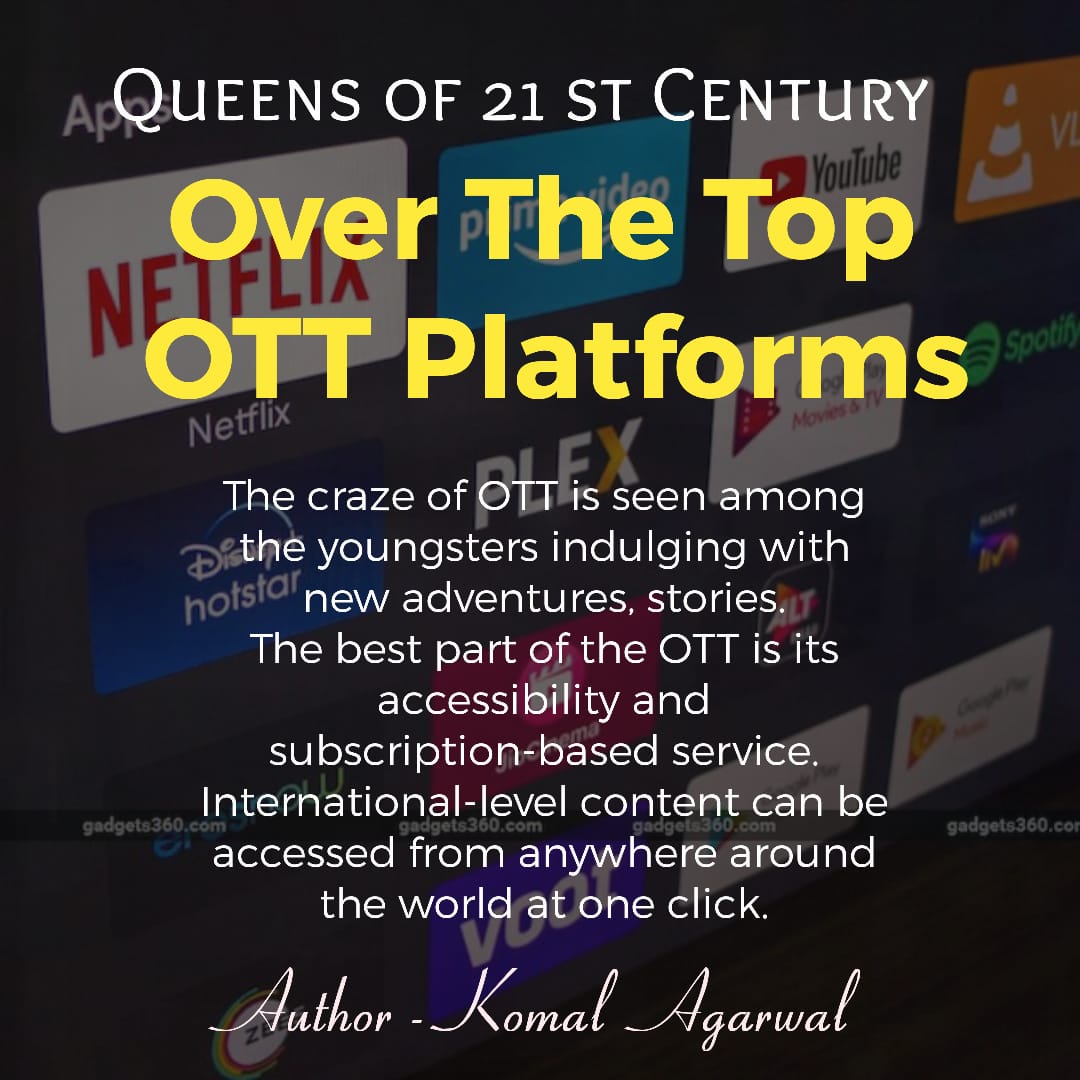
Queens of 21st Century : Over the Top (OTT) Platforms
This Article deals with the subject matter “Over-the-top (OTT) platforms”. The craze of OTT is seen among the youngsters indulging with new adventures, stories. The best part of the OTT is its accessibility and subscription-based service. International-level content can be accessed from anywhere around the world at one click.
Author : Komal Agarwal
ABSTRACT
This Article deals with the subject matter “Over-the-top (OTT) platforms”. The craze of OTT is seen among the youngsters indulging with new adventures, stories. The researcher has dealt with its meaning, pros, cons and judicial perspectives. Everything, whether it is invention or discovery, at first, appears to have its smooth running. With the passing of the time, it is misutilized by the hands of the humans. We all know that everything has its own both good and bad sides but we should only focus on the good side for the sake of the people and future. With the advancement of Technology, this world is becoming an unsafe place and it is the duty of Law to protect its people from all kinds of threats.
KEYWORDS: Social media, OTT platform, subscribers, web series.
Introduction
An OTT platform also known as “Over-the-top” platforms is a means of airing television and film programmes over the internet and to fulfill the requirements of the user or subscriber. The term itself means that a content provider is going over the top of existing internet services. It does not require any kind of cable operator, satellite connection, or other broadcast mediums.
The best part of the OTT is its accessibility and subscription-based service. International-level content can be accessed from anywhere around the world at one click.
The first dependent OTT platform in India was “BIGFlix”, launched by Reliance Entertainment in the year 2008. But today international- based Netflix and Amazon Prime Video and many others are amongst the largest platforms. If we see customer satisfaction, the subscription video-on- demand platforms Netflix and Amazon Prime Video also lead the way with scores of over 50%, speaking that a majority of users would recommend the streaming service to mates.
This Article focuses on all around matters depicting a clear picture and understanding of social media and OTTs
LIST OF SOME OTT PLATFORMS AND STATISTICS SHOWING MONTHLY ACTIVE USERS IN INDIA AS OF 2020
| S. NO. | NAME OF THE OTT PLATFORM | % OF ACTIVE USERS |
| 1. | MX Player | 27% |
| 2. | Disney+ Hotstar | 25% |
| 3. | Erosnow | 14% |
| 4. | JioCinema | 9% |
| 5. | Voot | 8% |
| 6. | Zee5 | 7% |
| 7. | Sony LIV | 6% |
| 8. | ALT Balaji | 2% |
| 9. | Amazon Prime | 1% |
| 10. | Netflix | 1% |
Pros and Cons of OTT platforms
Pros –
1. Affordable “monthly or yearly” subscriptions accessing thousands of programs at fingertips
2. Providing HD quality for both video and audio
3. Immediate and unlimited access anytime anywhere
4. Multicast services like smartphone, laptops, TVs and other audio- video devices
5. 100% original content guaranteed in these platforms
Cons –
1. Requires both account and unlimited internet access for long lasting viewing
2. Minimum internet speed of 2MBPS required for uninterrupted viewing
3. Misuse of the personal information of the customer in some distrusted OTT inviting cybercrimes.
4. Making the subscribers an introvert.
Challenges faced by an OTT platform
- Over-the-top (OTT) companies like Netflix, Prime Video, Google etc rule on the Telecom Industry thus the operators need to find ways to counter the threat.
- Bringing down the Average Revenue Per Unit (ARPU) which is calculated as total revenue divided by number of units, users.
- They implements their subscription methods with direct payment gateway untouched by taxation
- Privacy and security based risks and infringes.
- Risks of losing more ground to global competitors.
- Risk of access and service monopolization (to get complete control over the market).
- Negative impact on revenues, profit and employment for impacted sectors and firms.
- Global online TV and video revenues will reach US$ 42.34 billion in 2020 according to Digital TV Research which will definitely impact the OTT platforms.
Every now and then we hear fake, viral news which leads to loss of reliability of innocent people without any fault, viewers are misguided and can lead to harmful consequences. The introduction of Social Medias has acted as a base to criticize, blackmail the women as well as using rude and defamatory language against others. In case of any grievances, there was no Complaint Redressal means to give justice to the aggrieved party. Although the Social Media business in India has been on peak, Norms have been laid down for better business, security and future of the people.
The Information Technology (Intermediary Guidelines and Digital Media Ethics Code) Rules, 2021
The Information Technology (Intermediary Guidelines and Digital Media Ethics Code) Rules, 2021 were put forward by the Ministry of Electronics and Information Technology (MeitY). Social Medias like Facebook (410 million users), Twitter (17.5 million users), Instagram (210 million users), WhatsApp Messenger (530 million users), etc were given a time period of 3 months to act in accordance with the new rules. Some of the rules have been mentioned below –
- Significant social media intermediaries will have to appoint certain Officials who are ordinarily a resident of India namely –
- A Chief Compliance Officer
- A Nodal Contact Person; and
- A Resident Grievance Officer.
- On receiving complaints regarding any contents having nudity, sexual act or any kind of imitation, morphed images on any social media must be removed within such 24 hours.
- Social Media will have to hire a Grievance Officer whose work will be to take cognizance of the complaint within 24 hours and settle it within 15 days upon receiving such complaint.
- A compliance report showing the status of the complaints received and immediate steps taken have to be submitted by these platforms on a monthly basis.
- 2 broad divisions of social media intermediaries basing upon user number i.e. –
- social media intermediaries; and
- significant social media intermediaries (more than 50 Lakh registered users)
- Additional vigilance for significant social media intermediaries is demanded.
- Messaging platforms (Facebook, Instagram, Signal etc.) have been bound with a provision that they need to trace out the “first originator” of the information which may be viral, fake, spreading hate speech etc.
- In case of failure of due diligence by social media, they will be exempted from safe harbour provisions. It is a provision which will reduce the legal liability of these platforms in certain situations.
Code of Ethics have been laid down for OTT platforms, online news and digital media entities which are as follows –
- Over- the top (OTT) platforms (Netflix, Prime Video etc.) have to distinguish their authorized content into 5 age – based categories–
- U (Unrestricted)
- U/A (Unrestricted with Caution) 7+
- U/A 13+
- U/A 16+ and
- A (Adults Only).
- The contents certified U/A 13+ or higher must be ensured with parental locks.
- Genuine age verification is must for content certified as “A”.
- The subscribers must be informed regarding the rating of each show whether it is a movie, web series etc. along with content descriptor i.e. short narration of the story by the publisher for ease of decision before watching it.
- A Three-level Grievance Redressal mechanism has been setup which are –
- Level 1: Self-regulation by the publishers i.e. appointment of a Grievance Redressal Officer
- Level 2: Self-regulation by the publishers via self-regulating bodies; and
- Level 3: Oversight mechanism at Government level.
- This body firstly will have to register with the Ministry of Information and Broadcasting. Then it will take charge that the publisher sticks on to the Code of Ethics and takes in hand those grievances which have not been resolved within a reasonable time.
- The I & B Ministry will devise an oversight mechanism and publish a deed for self-regulating bodies, Codes of Practices.
- There will be a Grievance Redressal Officer who will have to resolve the disputes against the complaints within 15 days.
- There may be one or more Self-regulatory bodies being guided by a retired Judge of the Supreme Court, a High Court or an independent renowned person and not having more than 6 members.
- The grievances will be resolved via a setup called Inter- departmental Committee.
- Publishing of the news on digital media would be regulated under the provisions of Journalistic Conduct of the Press Council of India and the Programme Code under the Cable TV Networks Regulation Act.
As of now, the Resident Grievance Officer of India –
- Twitter, Bengaluru is Dharmendra Chatur
- For WhatsApp Paresh B Lal, Hyderabad
- Google LLC, Joe Grier, in Mountain View, California for India and
- Facebook named Spoorthi Priya.
Positive and Negative aspects of the New Rules
Positive aspects –
- The aggrieved party can reach the Redressal forums where appropriate actions will be taken within stipulated time.
- Traceability of the “first originator” of the fake, viral information will help to identify the right person to be held liable for such nuisance.
- These rules will impose legal liability on Social Media so that they cannot act reluctantly.
- Significant Social Media Intermediaries (SSMI) will have its own Redressal team of India consisting of a Chief Compliance Officer, a Nodal Person of Contact with Law enforcement agencies and a Resident Grievance Officer.
- It is obligatory for such Social Medias to remove or disable access to the contents that expose the private areas of individuals, show individuals in full or partial nudity or sexual act, impersonation, morphed images, etc within 24 hours of receipt of such complaints by the aggrieved party.
- The protocol says that the intermediaries must remove or disable any unlawful information within 36 hours.
- These platforms will have to provide information to the Authorized Government representative regarding the confirmation of identity for protection and/ or prevention against cyber security incidents within 72 hours upon receiving such order.
- Significant Social Media Intermediaries are required to have technology having automated tools and system such that it can identify the information that shows or depicts any form of an act of child abuse or its conduct.
- Cyber bullying and sexual abuse against children can be checked at times.
Negative aspects –
- The privacy of the users is at risk.
- The preservation of intermediary’s data, as per the rules, for investigative purposes is 180 days. The longer the preservation, the higher will be its cost.
- Each of the Social Media platforms will have to notify its users to avoid doing illegal activities otherwise it might lead to termination of their accounts at least once each year. It will lead to a burden on the host of web services to unnecessarily send users periodic emails.
- The digital platforms will have its Redressal team consisting mandatorily of 3 Indian residing Officers may become a hurdle for Multi- National Companies (MNCs).
- On one hand, Messaging platforms allow tracing of the “first originator” of information. It is further stated that this Order may only be passed for serious offences, but some categories are undefined. Although they may not have to disclose the contents of the message and details of the originator or other users, on the other hand, the Information Technology Decryption Rules have the authority to ask for the contents of the messages.
- The social media intermediaries are provided with immunity so that they are not legally liable for what their users do. The Intermediaries Rules, 2021 states that the penalty on such intermediaries will lead to loss of immunity and depending upon the level of severity of consequences, they might face criminal trial as per the provisions of the Information Technology Act and the Indian Penal Code.
Judicial perspectives
Some of the case laws have been discussed for a better clarity regarding release of movies, web series etc. on OTT platforms –
- Union of India vs. Dharma Productions & Ors AIR 2020
The Delhi HC asked the Central Government, Dharma Productions and other stakeholders to “sort out” their differences over the portrayal of Indian Air Force in Gunjan Saxena – The Kargil Girl
- Sameer Wadekar vs. Netflix Entertainment AIR 2020
In this case, the plaintiff Sameer Wadekar claimed that his story “Betaal” was an original script based on a fictional story and wanted an ad- interim injunction. The Bombay High Court declined to grant interim relief in a copyright infringement plea seeking to stay the worldwide release of Netflix horror series “Betaal” on May 24.
- Pranay Rai vs. Clean Slate Films Pvt. Ltd. & Others AIR 2020
Allahabad High Court rejected the fresh PIL which had demanded to stop the broadcast of the Amazon Prime web series by Court’s Order. The Court mentioned that the petitioner should make a complaint before a competent Central Government Authority.
- Karan Anshuman & Ors. vs. State of UP AIR 2021
The Allahabad High Court had granted a stay on the arrest of the writers and directors of the Amazon Prime web series, “Mirzapur” regarding a case registered against them for allegedly hurting religious and regional sentiments through their web series named of the town of Mirzapur in Uttar Pradesh.
- Aparna Purohit vs. State of Uttar Pradesh AIR 2021
The Supreme Court favoured “screening” of content aired on over-the-top (OTT) platforms, granted interim protection from arrest to Amazon Prime Video’s India head Aparna Purohit in the FIR registered by the Uttar Pradesh police over alleged hurting of religious sentiments by the web series “Tandav”. It was observed that protection from arrest will be subject to the petitioner cooperating with the investigation and appearing before the police as and when summoned.
Conclusion
The COVID – 19 pandemic gradually increased the fashion of Social media and OTT platforms as the theaters were forced to shut down and slowly the movies, web series started airing on these platforms. The people being forced to be home quarantined, of course, needed entertainment which was provided by these mediums by just a minimum amount of subscription to access unlimited programmes. As these platforms did not have any censorship, the directors wanted to show the real face of the society as presented in “Ashram”, “Tandav” and many more movies, web series which were in headlines too. As many people, communities have opposed the content descriptor of many programmes, and wanted an immediate action from the Court of Law. Different people have different mindsets and we all should be ready to face any challenges and try to regulate accordingly that can satisfy, protect a maximum number of people.
FOR ANY QUERY MAIL US AT EDUMOUNDOFFICIAL@GMAIL.COM
VISIT EDUMOUND.COM

